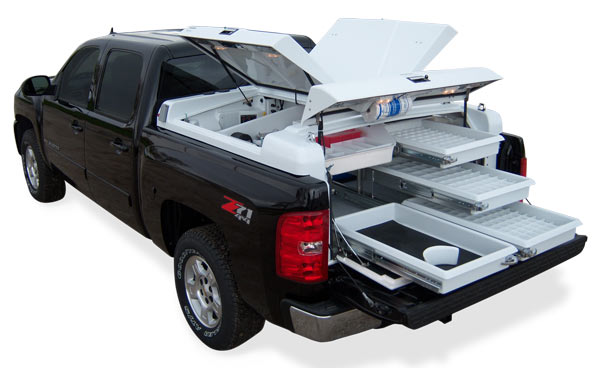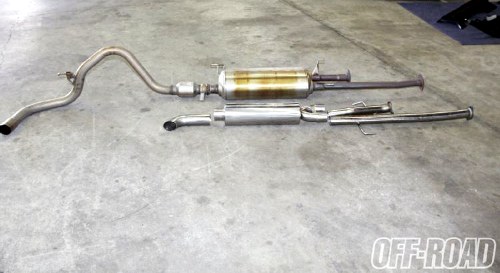 Archive for May, 2011
Archive for May, 2011
Safety and Fuel Economy Regulations Conspire To Reduce Truck Weight
One of the easiest ways to improve fuel economy is to reduce vehicle weight. Estimates range, but it’s safe to say that a 10% reduction in vehicle weight can boost fuel economy at least 5%, and perhaps as much as 10%. Weight reduction is also desirable because, unlike other fancier technologies (i.e. direct injection, variable valve lift, hybrid-electric, etc.) it’s a relatively simple and inexpensive process. If you want to cut vehicle weight, you:
- Find plastic you can replace with thinner plastic
- Find lightweight metal you can replace with heavy duty plastic
- Find steel you can replace with lighter metals
Simple, right?
OK – maybe not simple. Replacing a steel frame with a magnesium alloy (the most likely replacement material) means re-designing the entire vehicle…magnesium alloy is a different material with different assembly methods, so it’s not a matter of just swapping parts. Still, it’s less complicated to use alloys than it is to design fancy new engines, etc., which means that weight loss is a desirable method of fuel economy improvement.

Reducing the weight of the average pickup truck will improve fuel economy, but will consumers like the side effects?
Because pickup trucks are heavier than the average vehicle, and because a 10% improvement in truck fuel economy represents a greater fuel savings than a 10% improvement in car fuel economy, it’s logical to conclude that trucks must lose weight. The trouble is, consumers don’t necessarily want lighter vehicles (truck owners especially).
Thanks To An Earthquake, a Tsunami, and a Bail-out, GM Will Be World’s Largest Automaker Once Again
Thanks to $60 billion+ in U.S. and Canadian funds that saved the company and a tremendous, once in a thousand years natural disaster that’s crippled Toyota production, General Motors will likely be the world’s largest automaker for 2011. GM was the world’s largest automaker between 1932 and 2008, before losing the title to Toyota in 2009. While the value of being the “world’s largest” anything is dubious, there’s no denying that some people think being the world’s largest is an accomplishment.
If you find yourself talking to a person who thinks GM’s sales title is some sort of accomplishment, I’ve got some talking points for you.
1. Who cares? Does being the world’s largest automaker come with some sort of technological or economic advantage? Does every GM vehicle owner get a $100 rebate check as soon as GM becomes the world’s largest automaker, or does their GM product get an extra mpg after the award is announced? There’s nothing noteworthy about this statistic other than the statistic itself.
A Mobile Veterinary Clinic For Truck Owners
Veterinarians have it tough. Not only are they required to diagnose and treat animals which have no capability of explaining their symptoms, but they are also often called upon to provide care outside of a clinical setting. This is especially true for vets who work with livestock or wild animals in nature preserves and parks.

The Bowie Legacy 5 Mobile Clinic for Veterinarians.
The good news is, when a veterinarian has to make a “house call” (more like “ranch call”), they can bring the office with them. A company called Bowie offers a unique “mobile command center” that fits into the bed of most pickups, including the Toyota Tundra. The Bowie Legacy 5 is a task-focused “Insert Clinic” that provides many of the services that vets require in a package that can be delivered anywhere a four-wheel drive truck can access.
Excuses For Why The US Auto Industry Failed, And Then The REAL Reasons
GM icon Bob Lutz has a deserved reputation in the auto industry for being a visionary and an innovator. Lutz is a former Marine Corp aviator, a successful businessman, and he’s had a hand in developing a long and distinguished list of vehicles including the Dodge Viper, Ford Explorer, BMW 3-series, Cadillac CTS, the new Camaro…the list goes on.
In an interview at last week’s New York Auto Show, Lutz listed off five reasons for the failure of the US auto industry between the late 60’s and the last couple of years. These reasons are:
- Government fuel economy regulations
- Unfair Japanese exchange rates propped up by government subsidies
- Auto execs who were too focused on the bottom line
- The UAW (with the caveat that this was also partially a management failure)
- The media
You can read all of Lutz’s interview comments here (subscription req’d), but let me save you the trouble. Lutz just repeated the tired old excuses US car companies have used for decades. Here’s a break down:
Install A New Tundra Exhaust System in 27 Minutes
OffRoadWeb.com has a nice quick article that shows how installing an MBRP cat-back exhaust system takes just about 30 minutes (27, to be exact). While this install time assumes that:
- you have all the tools you need
- that you know how to use them
- that you have access to a vehicle lift
- that the underside of your Tundra is relatively rust and grime-free
it’s still a great illustration of just how easy it can be to install a cat-back after-market exhaust system on your Tundra. Most cat-back exhaust systems are designed to use factory exhaust hangers, which means that install can be really, really simple…especially on a newer truck where there isn’t any rust or grime to deal with.
If you’re thinking about adding a cat-back exhaust system to your Tundra, here are a few ideas to consider:


